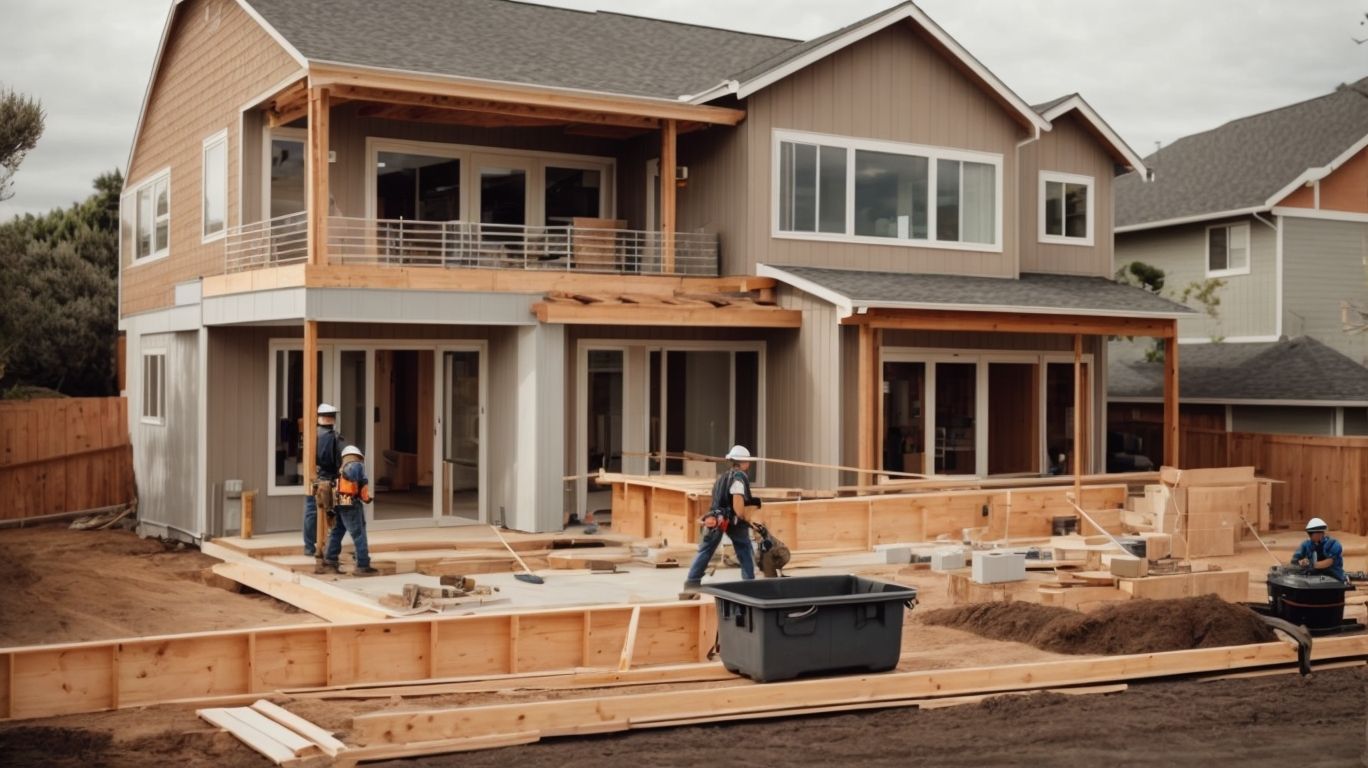
Navigating Permit Requirements for Your Second Story Addition: A Bay Area Homeowner’s Guide
Are you considering adding a second story to your home in the Bay Area?
If so, it’s important to understand the permitting process involved. This guide will walk you through everything you need to know, from the various types of permits required to the steps needed to obtain them.
Discover the building codes, zoning regulations, and structural requirements for second story additions. Learn about the benefits of hiring a professional to help with the process. Stay informed on the specific requirements and common challenges homeowners face in the Bay Area, and understand why proper permitting is essential for your project’s success.
What is the Permitting Process for Second Story Additions?
Understanding the permitting process for second story additions is crucial for homeowners embarking on a renovation project in the Bay Area. Navigating through the complex maze of permit requirements, zoning laws, and building codes is essential to ensure a successful construction project.
Homeowners looking to add a second story to their existing homes need to start by contacting the local planning department to begin the permit application process. This typically involves submitting detailed architectural plans, proposed construction timelines, and any other relevant documentation required by the city or county authorities. The planning department plays a vital role in overseeing the renovation project, ensuring that the construction meets all zoning regulations and complies with building codes. Working closely with the planning department can help streamline the permitting process and facilitate a smoother renovation experience for homeowners.
What Are the Different Types of Permits Required?
When undertaking a second story addition, homeowners are typically required to obtain various permits depending on the scope of the project. These permits may include building permits, permits for architectural plans, and approval from a structural engineer to ensure the structural integrity of the residential property.
Building permits are essential for second story additions as they ensure that the construction complies with local building codes and regulations. Permits for architectural plans are crucial, as they outline the design specifics and how the addition will integrate with the existing structure. The approval from a structural engineer is vital to assess the load-bearing capacity of the property and ensure that the structural modifications are safe and sound. Detailed architectural plans play a critical role in the permitting process, providing a roadmap for construction and facilitating a smoother approval process.
What Are the Steps Involved in Obtaining Permits?
Obtaining permits for a second story addition involves a series of steps that homeowners need to follow diligently. These steps typically include submitting a permit application, sourcing appropriate construction materials, hiring qualified contractors, scheduling inspections, paying permit fees, and ensuring compliance with legal requirements.
- Once the permit application has been filled out completely, it should be submitted to the local building department along with any required documentation. Homeowners must ensure that the application includes detailed plans and specifications for the second story addition, as well as information about the construction materials that will be used.
- Engaging with licensed contractors who are familiar with the permit process and legal requirements is crucial to a smooth building experience.
Regular inspections by building officials must be scheduled at key milestones to ensure that the construction meets safety standards and regulations.
How Do I Determine if My Home is Eligible for a Second Story Addition?
Assessing the eligibility of your home for a second story addition requires a thorough evaluation of various factors, including the potential for home improvement, the impact on property value, the availability of building permits, and the feasibility of residential construction.
Understanding the current layout of your home is crucial when considering a second story addition. Factors such as the existing foundation, structural integrity, and space utilization all play a key role in determining if a second story is a viable option.
Hiring a qualified contractor to assess the structural capacity of your foundation and the overall feasibility of adding a second story is essential. It’s also important to consider any zoning restrictions, neighborhood covenants, and building codes that may affect the expansion project.
What Are the Building Codes and Zoning Regulations for Second Story Additions?
Before planning a second story addition, homeowners must familiarize themselves with the building codes and zoning regulations that govern such projects. Understanding these regulations is vital to ensure compliance with zoning laws, uphold property values, and navigate the competitive housing market.
Building codes establish standards for construction, ensuring structural integrity and safety. Zoning regulations, on the other hand, dictate how properties can be used and developed within specific areas. By following these guidelines, homeowners can prevent potential legal issues, maintain neighborhood aesthetics, and potentially increase the resale value of their homes.
Adhering to building extensions also contributes to the overall urban planning and development of the community, promoting sustainable growth and efficient land usage. Therefore, when considering a second story addition, homeowners should prioritize aligning their plans with the relevant housing regulations and zoning laws.
What Are the Structural Requirements for Second Story Additions?
Ensuring the structural integrity of a second story addition necessitates compliance with specific requirements outlined by structural engineers and reflected in architectural plans. Securing the relevant building permits, sourcing appropriate construction materials, and adhering to these structural requirements are essential steps in the construction process.
Structural engineers play a crucial role in evaluating the existing foundation and ensuring that it can support the additional load of a second story. Detailed architectural plans are instrumental in visualizing the design and layout of the new space while incorporating necessary structural reinforcements. Building permits are necessary to ensure that the construction meets safety and zoning regulations.
Selecting suitable construction materials, such as steel beams, timber frames, or reinforced concrete, is vital to ensure durability and longevity of the added structure. Following the structural guidelines meticulously throughout the construction process is paramount in guaranteeing a safe and stable second story addition.
What Are the Benefits of Hiring a Professional for Permitting?
Engaging a professional for the permitting process offers numerous advantages, including expert guidance on design and planning, access to quality construction materials, connections with reliable contractors, and oversight during crucial inspections.
These professionals bring a wealth of experience to the table, ensuring that your project is not only compliant with regulations but also optimized for efficiency and functionality. They can recommend sustainable and cost-effective construction materials that are durable and visually appealing. Their established network of skilled contractors ensures that the construction process runs smoothly, with timely completion and high-quality workmanship. Their role in managing inspections guarantees that all necessary approvals are obtained, giving you peace of mind throughout the entire building process.
How Can a Professional Help with Design and Planning?
Professionals play a crucial role in assisting with the design and planning of second story additions, offering expertise in creating detailed architectural plans, selecting appropriate construction materials, managing project timelines, and ensuring adherence to relevant building codes.
Their involvement in the initial stages of a project is essential in translating clients’ visions into tangible blueprints that align with both aesthetic preferences and structural requirements. Through meticulous attention to detail, these professionals collaborate with clients to identify the most suitable materials that meet quality standards while staying within budget constraints. Their adept project management skills ensure efficient coordination of various stakeholders, from architects to subcontractors, to facilitate a seamless construction process. Concurrently, strict adherence to building regulations is diligently maintained throughout the project timeline to guarantee structural integrity and safety compliance.
What Are the Risks of Not Obtaining Proper Permits?
Ignoring the need for proper permits can expose homeowners to various risks, including costly permit fees, legal repercussions for non-compliance with city regulations, negative impacts on property value, and challenges in the competitive housing market.
Failure to obtain permits may result in significant financial burdens, as the issuance of permits often involves fees that can accumulate and strain the project budget. Non-compliance with legal requirements can lead to fines, stop-work orders, or even legal action from local authorities, further escalating costs and disrupting project timelines. Disregarding city regulations can diminish the overall appeal and value of the property, making it less attractive to potential buyers in the future housing market.
Navigating the Permitting Process in the Bay Area
Navigating the permitting process for second story additions in the Bay Area presents unique challenges and requirements that homeowners must navigate.
Whether you are looking to add extra living space to accommodate a growing family or enhance the value of your property, securing permits in the Bay Area can be a complex process. Homeowners often find themselves grappling with strict building codes, zoning regulations, and design guidelines specific to the region.
Common challenges include obtaining approval from neighborhood associations, ensuring compliance with earthquake safety standards, and addressing concerns about privacy and light obstruction. Being well-informed and proactive in the permits processing stage is essential to avoid delays and setbacks in your renovation journey.
What Are the Specific Requirements for Second Story Additions in the Bay Area?
Second story additions in the Bay Area are subject to specific requirements dictated by local housing development plans, neighborhood regulations, and housing laws. Complying with these regulations is essential to ensure that building extensions align with the region’s urban development goals.
Local housing development plans play a crucial role in guiding construction projects in the Bay Area. These plans outline the vision for the region’s growth and design standards that need to be followed when adding a second story to a property.
Neighborhood regulations set by local governing bodies ensure that new constructions blend harmoniously with the existing architectural landscape. Adhering to these regulations helps maintain the aesthetic appeal and character of the neighborhood, fostering a sense of community pride and cohesion.
Housing laws further dictate specific parameters for second story additions, addressing issues such as safety standards, zoning restrictions, and environmental considerations.
What Are the Common Challenges Homeowners Face in Obtaining Permits in the Bay Area?
Homeowners in the Bay Area encounter common challenges during the permitting process, such as securing suitable construction sites, managing home renovation projects effectively, adhering to construction timelines, and navigating neighborhood guidelines that impact construction activities.
When it comes to site selection for second story additions, homeowners often face the dilemma of finding the right balance between proximity to existing structures and adherence to zoning laws.
Project management becomes crucial in overseeing multiple aspects concurrently, from coordinating with contractors and suppliers to monitoring budget allocations. Timely completion of construction projects is vital, as delays may result in additional costs and inconvenience.
Ensuring compliance with neighborhood guidelines, such as height restrictions and architectural styles, is essential to avoid potential legal challenges and setbacks.




No Comments